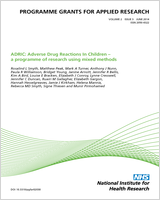Included under terms of UK Non-commercial Government License.
NCBI Bookshelf. A service of the National Library of Medicine, National Institutes of Health.
Kendrick D, Ablewhite J, Achana F, et al. Keeping Children Safe: a multicentre programme of research to increase the evidence base for preventing unintentional injuries in the home in the under-fives. Southampton (UK): NIHR Journals Library; 2017 Jul. (Programme Grants for Applied Research, No. 5.14.)

Keeping Children Safe: a multicentre programme of research to increase the evidence base for preventing unintentional injuries in the home in the under-fives.
Show detailsThe KCS programme makes the following recommendations for research.
Important recommendations for research
- Further intervention studies, preferably RCTs, to evaluate the effectiveness and cost-effectiveness of home safety interventions. These need to provide detailed descriptions of intervention and control arm treatments, and measure and report injury outcomes, home safety equipment use and safety behaviours. Studies should explicitly report how they addressed potential barriers and facilitators in the design of their intervention and explore barriers to and facilitators of implementing interventions from a range of perspectives.
- Further intervention studies, preferably RCTs, to explore the effectiveness and cost-effectiveness of delivering other injury prevention interventions within children’s centres and of IPBs implemented by different professional groups and in different settings.
- Further meta-analyses, particularly of studies measuring injury outcomes and safety behaviours, as the number of primary studies increases.
- Pairwise meta-analyses and NMAs incorporating covariate information to evaluate whether or not targeting interventions at specific population groups is more effective than providing non-targeted interventions.
- Further economic evaluations to enhance the evidence base for the prevention of fire-related injuries, scalds, falls and poisonings in childhood. Economic evaluations should measure the NHS, family and societal costs of a wide range of injuries, using large representative samples of injured children. Studies measuring utility decrements for a wide range of childhood injuries requiring different levels of health-care resource use would be particularly useful. Economic evaluations are needed that evaluate within a single analytical model complex multicomponent interventions such as home safety schemes providing education and safety equipment to prevent a range of injuries. Future studies may want to consider both welfare and quality of life more broadly (e.g. a cost–consequence analysis or a multicriteria decision-making approach), but thresholds would need careful consideration as it is unclear whether or not a threshold of £30,000 per QALY gained is relevant to different sectors of the economy beyond health care.
Recommendations for research of interest but of lesser importance
- UK studies that explore the effect on the estimation of costs of using parent-reported data compared with health-care resource use data obtained from medical records.
- Studies to explore why retrospectively reported pre-injury HRQL scores tend to be higher than those for the general population from whom the injured sample is drawn.
- Further investigation of the psychometric properties of the PedsQL in a large sample of healthy UK toddlers (a general population sample) using modern psychometric methods such as item response theory.
- Further surveys of injury prevention activity to assess the extent to which children’s centres are fulfilling their remit to deliver injury prevention activities as they continue to develop and evolve.
- Qualitative and quantitative studies to evaluate the use of ‘real-life’ injury experiences as learning opportunities for parents within injury prevention interventions.
- Recommendations for research - Keeping Children Safe: a multicentre programme of...Recommendations for research - Keeping Children Safe: a multicentre programme of research to increase the evidence base for preventing unintentional injuries in the home in the under-fives
Your browsing activity is empty.
Activity recording is turned off.
See more...